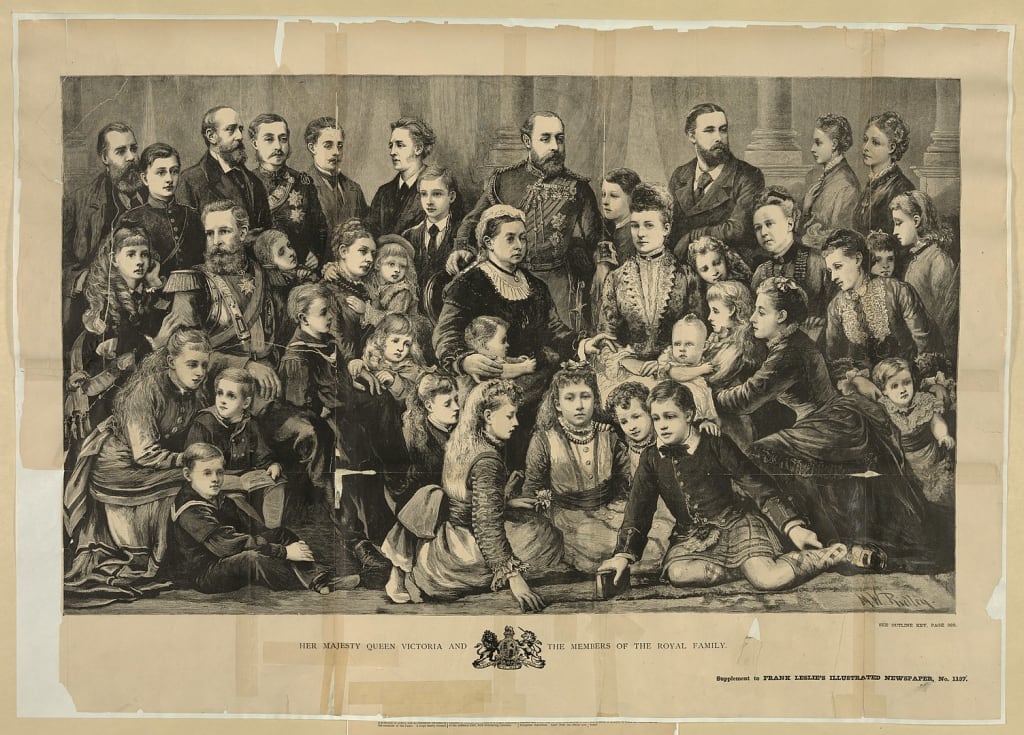The History of the Royal Disease
How haemophilia ravaged the European royal family

By the late 18th-early 19th century, the extended family of Queen Victoria had stretched throughout the European continent. With nine children of her own, marrying each of them off to Europe’s wealthiest and most powerful, her influence spread across the globe. But thanks to what would become known as ‘the Royal disease’, she was unknowingly spreading far more.
Haemophilia is a mostly inherited disease that affects the blood’s ability to form clots, in mild cases just causing complications in serious injury and surgery, but in more severe cases making a simple bruise or scrape life threatening. As Victoria’s extended family grew, and science became more and more aware of the condition, it weakened dynasties, highlighted the problems with autocracies and monarchies as a whole, and raised major question marks to the natural law of succession that had existed for hundreds of years.
The Family tree above highlights this perfectly in the royal family. Those in black are carriers of the haemophilia gene (typically the women), while those in red are the sufferers (the men). Although Queen Victoria of England had 9 children, only three would be impacted by the gene directly (two carriers, one sufferer), but that would be enough through their children to spread across the continent. She died in 1901 outliving her youngest son and one of her grandchildren, but far more of her descendents would do.
In total, there were ten members of her extended family, all men, who were known to suffer from the disease. Here are their fates.
Prince Friedrich of Hesse and by Rhine, died 29 May 1873 — Victoria’s grandson
Born in October 1873, ‘Frittie’, as he was called, was the son of Queen Victoria’s daughter Alice. He was only diagnosed with haemophilia a few months before he died, after he cut his ear and the bleeding wouldn’t stop for three days.
Before he even reached his third birthday, he fells 20 feet from a window when playing with his brother, dying of a brain hemorrhage shortly after. If he wasn’t a haemophiliac, he might have survived.
Prince Leopold, Duke of Albany, died 28 March 1884 — Victoria’s son
The youngest son of Victoria, he was understandably fragile due to the condition, spending much of his younger years confined to bed, often unable to walk due to the severe joint pain the disease would cause him. Leopold’s life was a constant struggle, due in part to the disease, but also due to his overly protective and controlling mother, yet his short life was somewhat of a triumph in overcoming adversity and accomplishment in spite of it all.
As her other children grew up and left home to get married, Victoria expected Leopold to always stay with her in the family home, working as her secretary and staying close where she could keep an eye on him. But Leopold was an intellectual boy, and although he was aware of his condition and the limitations it imposed on him, he dreamed of independence. Becoming stifled at home with his overbearing mother, he went to university, and became a patron of chess, the arts, and literature. Due to his illness, Leopold had much difficulty finding a wife, and his meddling mother rejected many of his choices, reluctantly agreeing to help when it became clear that he may marry outside of royalty if she didn’t.
Leopold married Princess Helena of Waldeck and Pyrmont in 1882 and the following year, had their first child together, whom they called Alice after Leopold’s sister, and who would become a carrier of the haemophilia gene herself. In 1884, while in Cannes receiving treatment, and while Helena was pregnant with their second child, Leopold slipped and fell, banging his knee and head, dying shortly afterwards aged 30.
Prince Heinrich Friedrich of Prussia, died 26 Feb 1904 — Victoria’s great-grandson
The son of Princess Irene (daughter of Victoria’s daughter Princess Alice), the Prince of Prussia was another to die young, suffering a similar fate to his uncle, Prince Friedrich.
Playing at home one day, he climbed a table, fell, and landed headfirst on the floor. He quickly lost consciousness, and died of a brain hemorrhage a few hours later. The doctor’s all agreed that the fall had been minor, and most children would have recovered, but for a haemophiliac such an accident was often fatal.
Prince Maurice of Battenberg, died 27 October 1914 — Victoria’s grandson
The son of Princess Beatrice (Victoria’s youngest daughter), a known carrier of the disease, Maurice is thought by many to have been a haemophiliac, but the fact he was able to serve in the army during World War I has thrown this in to dispute. At most he suffered from a very mild version of the disease, and little is recorded of his health at all.
Perhaps if Maurice had lived longer, this could have been decided for definite, but he would not live beyond 23. Leading an advance on a German front in 1914 as a Lieutenant in the King’s Royal Rifle Corps, a shell landed right by him. He died almost at once, becoming the only member of the British Royal Family to die in the Great War.
Tsarevich Alexei of Russia, died 17 July 1918 — Victoria’s great-grandson
Alexei’s haemophilia and death had, perhaps, the largest ramifications of all Victoria’s descendents. Passed to him by his mother Alix of Hesse, who married Tsar Nicholas II of Russia to become Tsarina Alexandra, Alexei was the long awaited heir to the throne of the largest nation in the world.
After many years of Nicholas and Alexandra struggling to produce a heir they finally celebrated with the news on 12 August 1904, but from his birth it became apparent something was wrong. A simple bruise or cut would result in a life threatening condition for Alexei, and more than once the family confessor was called in to give him the last rights, only for the boy to pull through at the last moment. Although the affects of haemophilia were known by this point, a cure was not, and court doctors would often prescribe Alexei with aspirin as he recovered, not realising that this thinned his blood and was actually killing him.
The family kept Alexei’s condition a state secret for a long time. Alexei’s parents put all their faith in the mystic holy man Grigori Rasputin, who seemed to heal Alexei on more than one occasion (historians believe now this was because Rasputin told Alexandra and Nicholas to send the doctors away, thus saving him from the aspirin they were prescribing). Rasputin’s presence acted as a fuse on which the already flammable Russian monarchy sat, and with that the February Revolution of 1917 saw Nicholas II abdicate. With no strong successor in line, the Romanov dynasty ended after 304 years, and just over a year later, Alexei and his entire family were executed by a Bolshevik firing squad.
When the secretly buried bodies of the family were discovered and DNA tests were carried out to prove their identities, it was finally discovered via Alexei’s body in 2009 that ‘the Royal disease’ was in fact haemophilia B.
Lord Leopold Mountbatten, died 23 Apr 1922 — Victoria’s grandson
The middle boy of Princess Beatrice’s three Princes of Battenberg (a name they changed, and title they relinquished in favour of Mountbatten due to uncomfortable associations to the Germans during WWI), Leopold, like his two brothers, also sought to distinguish himself during the war.
While some dispute whether his younger brother Prince Maurice was actually a haemophiliac after all, there are few that question Leopold’s health. Known as a fragile boy and protected from a lot of physical activities growing up, he was nevertheless able to serve, doing so as a Lieutenant of the King’s Royal Rifle Corps during the First World War, before being moved in to a non-combat position of aide-de-camp. After suffering a fall, was invalided and sent home in 1915.
He died in 1922, aged 32, during a hip operation. Many historians today commend Leopold on the bravery he showed to enlist and serve, in spite of his health and the increased dangers he would face due to the blood disease, when a simple trip and fall could have proven fatal.
Prince Rupert of Teck, died 15 Apr 1928 — Victoria’s great grandson
Son of Princess Alice of Albany (who was daughter of Prince Leopold of Albany), Rupert was diagnosed as a haemophiliac at an early age, although not much is recorded as to how this effected his day to day life.
As part of the anti-German sentiment and relinquishing of German titles, his father gave up the title of Prince, and Rupert became Viscount Trematon. He died aged 20 in a car accident, when he crashed in to a tree when out driving with two friends. One of those friends died instantly, another was only slightly injured, and Rupert himself suffered only a small fracture to his skull. As a haemophiliac, however, this proved fatal, resulting in an intracerebral hemorrhage, which he succumbed to several weeks later.
Infante Gonzalo of Spain, died 13 Aug 1934 — Victoria’s great-grandson
The disease reached Spain via Princess Beatrice’s daughter, Princess Victoria Eugenie, who married King Alfonso XIII. The King’s youngest son, Infante Gonzalo was diagnosed with haemophilia early, but his ill-health was kept secret from the public during his lifetime.
Born in 1914, Gonzalo was the last known sufferer of the royal disease to be born. When the monarchy was abolished in elections and declared itself a Republic in 1931, Gonzalo joined his mother in exile and studied in Belgium. When he was 19, he was out driving with his sister and crashed in to a wall. Neither appeared injured, but like many of his relatives before him, his haemophilia would lead to complications. He died two days later from abdominal bleeding.
Alfonso, Prince of Asturias, died 6 Sep 1938 — Victoria’s great-grandson
Gonzalo’s older brother, Alfonso was heir apparent to the Spanish throne before he officially renounced his rights in 1933. He did so, however, in controversial circumstances, giving up his rights in order marry a commoner, whom he divorced a few years later, before marrying and divorcing another shortly after.
Disowned by his father, Alfonso moved to Miami, Florida, and in 1938, on his way home with a friend, the car he was in swerved and crashed in to telephone booth. Neither Alfonso or the driver seemed to be harmed, but in tragically similar circumstances to his younger brother, his haemophilia resulted in internal bleeding, and he died aged 31.
Prince Waldemar of Prussia, died 2 May 1945 — Victoria’s great-grandson
Born in 1889 to Princess Irene of Hesse and by Rhine (the daughter of Princess Alice — herself daughter of Victoria), Waldemar was diagnosed with the disease, and was surrounded by constant reminders of the danger he was in. His uncle Prince Friedrich had died young to the same condition before he was born (see above), and he grew up to see his younger brother Heinrich meet an eerily similar fate, while his first cousin the Russian Tsarevich Alexei was repeatedly on his deathbed with his own struggles.
Yet despite all of this, Waldemar lived far longer than any of his haemophiliac relatives. Living through the First World War and the bulk of the Second, Waldemar and his wife were fleeing from the advancing Russian army, and arrived in Germany hoping he could receive a blood transfusion. However, the US Army overran the area the following day, diverting all medical resources to treat concentration camp victims, which resulted in Waldemar’s doctor being unable to treat him. He died of bleeding from the stomach a day later.
And with that, the last descendent of Queen Victoria known to suffer from the royal disease had died. With each passing generation down the female line, the likelihood of inheriting the haemophilia gene decreases, and today, no members of the current or previous European monarchies are known to suffer from the disease.
* * *
About the Creator
R P Gibson
British writer of history, humour and occasional other stuff. I'll never use a semi-colon and you can't make me. More here - https://linktr.ee/rpgibson






Comments
There are no comments for this story
Be the first to respond and start the conversation.